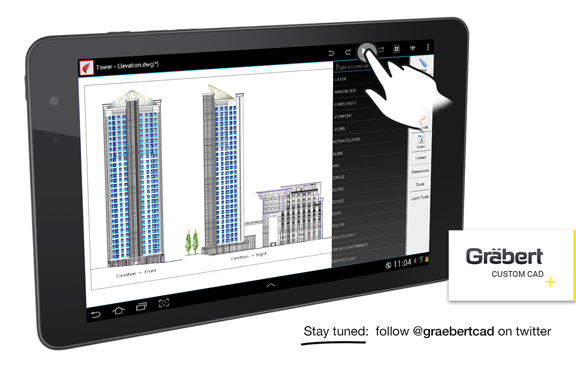Latest News
June 4, 2014
Germany-headquartered Graebert hopes to be the first company to deliver a 2D-3D CAD program for Android tablet users. The product, codenamed Radon, will be based on the same modeling engine powering the company’s current desktop CAD package ARES, DraftSight from Dassault Systemes, and CorelCAD from Corel.
In the press announcement, Graebert states, “Radon natively reads and saves files in DWG, enabling Graebert customers to experience the same 2D drafting and 3D modeling features, user experience, and programming environment across Android, Mac, Windows, and Linux. Radon adds the power of a touch-enhanced UI in addition to an Android-enhanced UX as an enhancement to the standard ARES feature set. Radon includes also the same APIs as ARES Commander (Tx C++, LISP, FDT), offering CAD developers a unique opportunity to migrate their applications from desktop to mobile. Through Radon, developers will be able to offer the same functionality and features on both tablet and desktop while maintaining the same core stream of code.”
Wilfried Graebert, CEO and founder of Graebert, reasoned, “By 2015, tablets will outsell PCs by a significant margin—as such, the importance of making the full ARES CAD experience available on mobile devices became a top development priority. By 2017, there will be touch devices (smartphones + tablets) shipped for each PC and we fully intend to be the go-to solution for handheld devices long before then.” Graebert doesn’t think the tablet version CAD program will replace the desktop version, but “it’ll be a natural extension of the desktop version.”
“We have statistics that show the market for Android tablet is much more interesting,” said Graebert. “The iOS version will be considered for the future, but the Android version is the priority for us.”
Graebert plans to show Radon for the first time and discuss pricing in October at the company’s annual meeting in Berlin.The company is now accepting beta tester applications for its new product.
Graebert is not alone in placing a heavy bet on mobile devices as the hardware for professional CAD. Autodesk made available AutoCAD 360, a robust viewing, sketching, and markup program. It began life in Autodesk Labs under the codename Autodesk Butterfly, evolved into a product called AutoCAD WS, then settled into the company’s cloud-hosted product portfolio as AutoCAD 360. Similarly, ISMI/Design, makers of TurboCAD, hopes to capture the groundswell in tablet users with its CAD product DoubleCAD XT.
The rising popularity of mobile tablets present a dilemma for professional CAD software developers. Traditionally selling their products at $2,500 to $5,000 per seat to desktop users through resellers, these vendors are now forced to come up with ways to accommodate the integration of mobile devices in the next-generation engineers’ workflow. Since mobile apps for tablets are typically priced $0 to $10 on Apple app store and Android market and sold directly to consumers, CAD vendors who want to tackle the tablet market must learn to thrive on large volume sales with micro payment—the opposite of how desktop CAD software have historically been distributed. They may also distribute some mobile editions freely (like Autodesk, Dassault, and IMSI/Design have done with some of their products) as a way to entice new users to explore and discover the professional products.
Graebert’s strategy will become clear in October.
Subscribe to our FREE magazine, FREE email newsletters or both!
Latest News
About the Author
Kenneth Wong is Digital Engineering’s resident blogger and senior editor. Email him at [email protected] or share your thoughts on this article at digitaleng.news/facebook.
Follow DE






